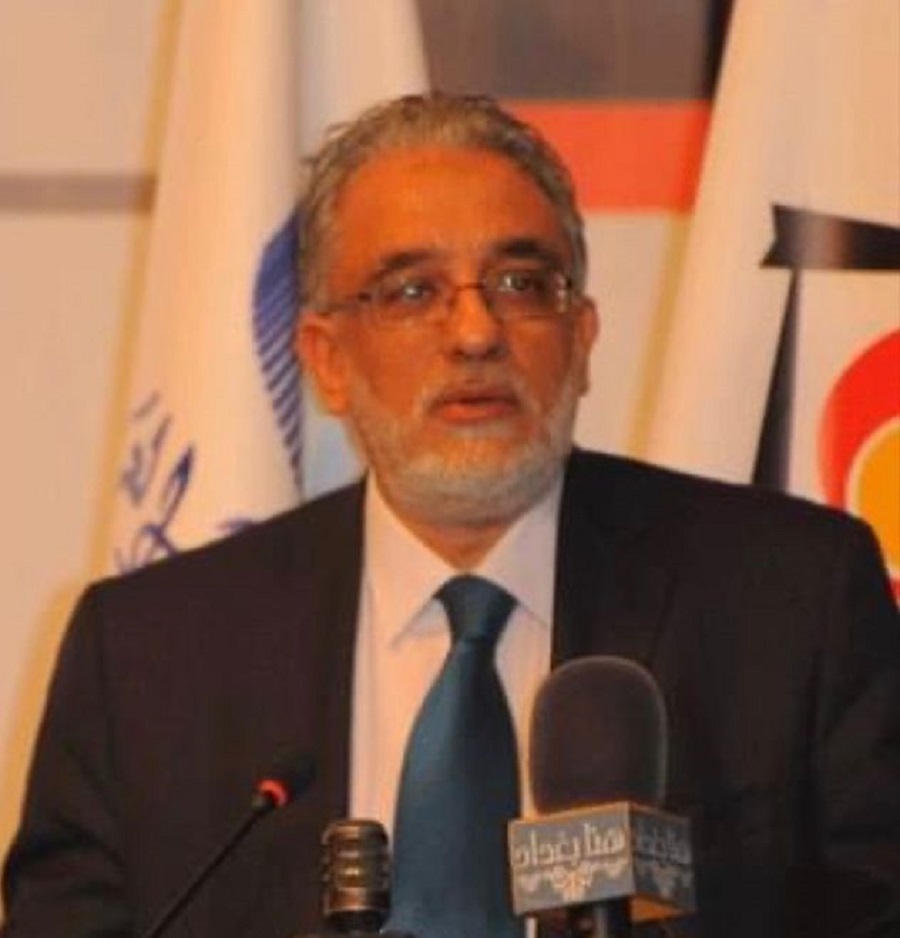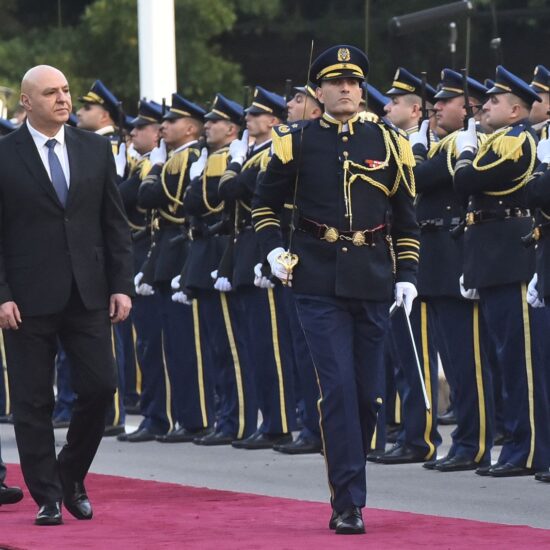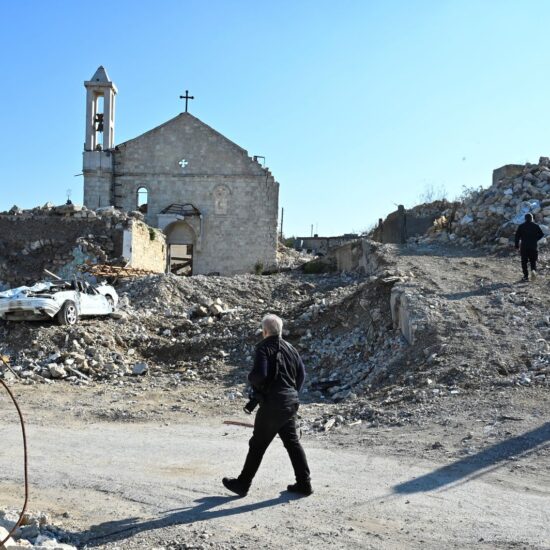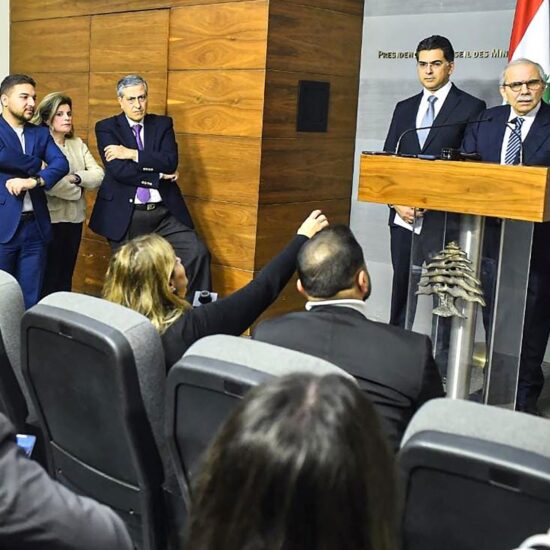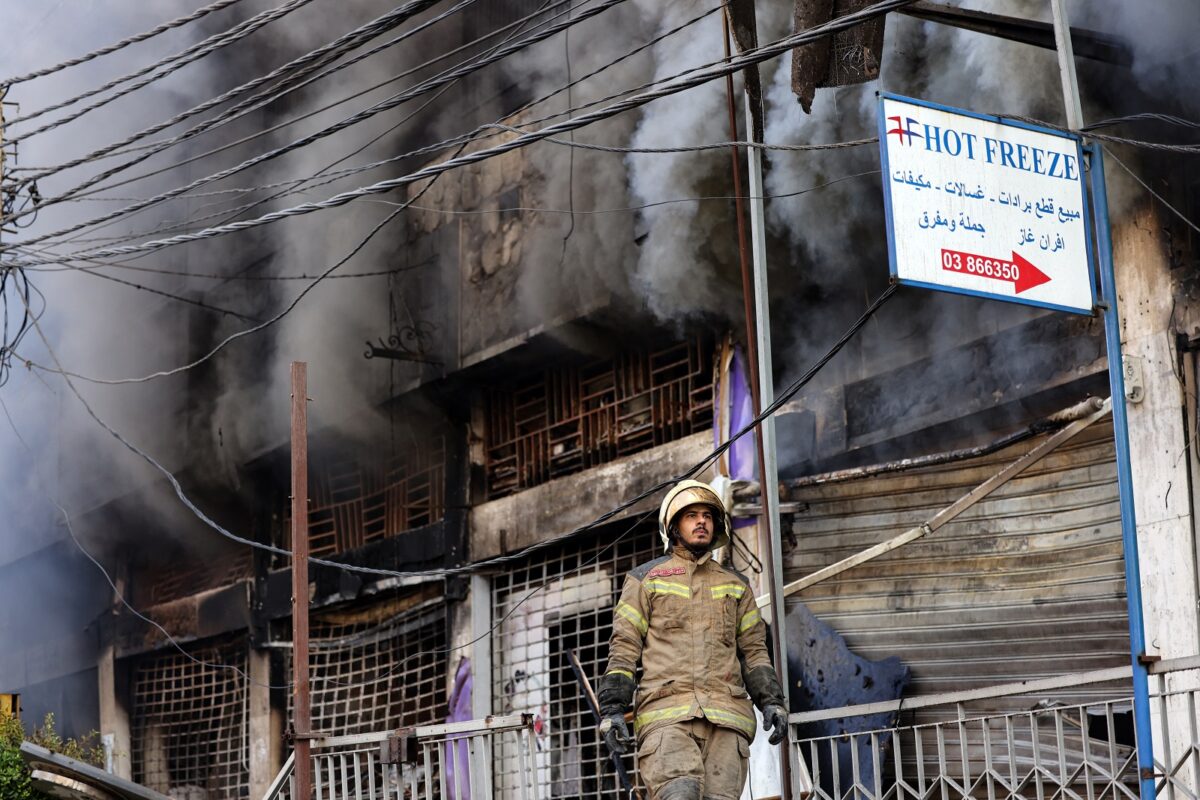
Rebuilding the Lebanese state with a strong army, backed by a population weary of hezbollah’s violent vision of resistance, is an attainable goal. Achieving this will demand focused American commitment and strong political resolve. however, the question remains: can general Aoun navigate Lebanon's intricate political landscape and garner broad-based support, or will his potential candidacy deepen existing divisions?
On October 7, 2024, the Middle East was shaken by a coordinated multi-front attack that sent shockwaves across the region and the globe. Hezbollah and allied militant groups launched an unprecedented assault on Israel’s northern border, leading to a rapid escalation of violence. The surprise offensive, which many believed had been orchestrated with Iranian backing, left Israel reeling and exposed the fragility of a region already on the brink.
Beyond the immediate violence, October 7 signaled a profound shift in the balance of power in the Middle East, with far-reaching implications for global politics and the economy. While the conflict itself was devastating, with thousands of casualties and widespread destruction, the longer-term consequences of this event have reshaped regional dynamics. The events of October 7 marked a point of no return for Middle Eastern geopolitics, revealing the rising influence of Iran, the retreat of U.S. power, and the assertive roles of Russia and China.
The United States now has the potential to make a significant impact. For over a decade, U.S. Central Command, which oversees the Middle East, has collaborated closely with the Lebanese Armed Forces (LAF), aiming to strengthen their capacity to regain control over the nation’s borders if Hezbollah’s influence were ever to diminish.
General Joseph Aoun critical path
The prospect of General Joseph Aoun assuming a greater political role, or even the presidency, raises important questions about whether all Lebanese factions would accept him as a unifying figure. Lebanon’s deeply sectarian political system means that any candidate, particularly one emerging from the military, faces significant scrutiny from various political and religious groups. While General Aoun is viewed as a neutral leader with the ability to rise above partisan politics, his acceptance by Hezbollah and its allies remains uncertain. Hezbollah, which wields considerable power and maintains its own military wing, may view Aoun’s presidency with suspicion, particularly given his close ties to Western governments and his emphasis on strengthening the LAF. Additionally, some civilian political groups may be wary of endorsing a military figure in a country with a complex history of military interventions in politics.
The question remains: can General Aoun navigate Lebanon’s intricate political landscape and garner broad-based support, or will his potential candidacy deepen existing divisions?
The nomination of Lebanese Armed Forces (LAF) General Joseph Aoun for the presidency comes within a complex web of international divisions, reflecting the broader geopolitical struggles shaping Lebanon’s future. While General Aoun has gained favor among key Western powers, particularly the United States and France, who see him as a stabilizing figure capable of countering Hezbollah’s influence, his candidacy faces resistance from regional actors with conflicting interests. Hezbollah, backed by Iran, may perceive his presidency as a threat to its military dominance, especially given the LAF’s increasing capabilities bolstered by Western military aid. Similarly, Syria, which maintains significant influence in Lebanon, may view Aoun with skepticism due to his perceived alignment with Western priorities. In contrast,
Gulf nations like Saudi Arabia, which are engaged in a regional power struggle with Iran, may support Aoun’s candidacy, hoping his leadership would weaken Hezbollah’s grip and reduce Tehran’s influence in Lebanon. However, this alignment would further complicate Lebanon’s internal politics, as Hezbollah’s allies, including political factions linked to Syria, are likely to push back against any presidency they deem hostile to their interests. This international tug-of-war adds layers of complexity to Aoun’s potential presidency, making the path to consensus in Lebanon even more fraught. Lebanon’s deep-rooted sectarian system only magnifies these external pressures, with each local faction aligning itself with international patrons to secure its interests.
Which U.S. Influence
To understand the broader implications of October 7, one must look at the collapse of U.S. influence in the Middle East. For much of the 20th century and early 21st century, the United States was the primary architect of regional security. It propped up key allies like Saudi Arabia, Egypt, and Israel while isolating adversaries like Iran.
That critical moment seems to have finally come. The Pentagon has been rehearsing for this role for several decades through its support program for the LAF. Less than four months ago, the Pentagon hosted the LAF’s commander, Gen. Joseph Aoun, in Washington and at Centcom headquarters in Florida. Today as the event folds Lebanon is seeking a new president and not surprisingly the name of LAF Gen Joseph Aoun seems to be a favorite. According to a report by Al-Monitor during President Aoun’s visit in mid-June, Biden administration officials are urging the Lebanese Armed Forces (LAF) to ready a force that could be stationed near the border to oversee a potential buffer zone negotiated between Israel and Hezbollah. Amos Hochstein, Biden’s special envoy to Lebanon, emphasized that such a deployment would demand “a significant amount of funding,” noting, “It takes time to recruit, train, and equip the necessary forces.”
Rebuilding the Lebanese state with a strong army, backed by a population weary of Hezbollah’s violent vision of resistance, is an attainable goal. Achieving this will demand focused American commitment and strong political resolve. However, it is a crucial endeavor for Joe Biden’s remaining time in office and for the administration that follows.
However, over the last two decades, U.S. influence has steadily declined, largely as a result of its failures in Iraq and Afghanistan. The hasty withdrawal of U.S. troops from Afghanistan in 2021, a chaotic exit that left the Taliban back in control, signaled the beginning of the end of American dominance in the region. Though Washington remained involved through diplomatic channels and military support, its once overwhelming presence in the Middle East was fading. In the wake of October 7, this decline became even more apparent. U.S. diplomatic efforts to de-escalate the situation were met with skepticism and indifference from key regional players, particularly Iran and Russia. Washington’s attempts to mediate between Israel and its adversaries had lost their potency. The traditional model of U.S.-brokered peace agreements, which had defined the region’s diplomacy for decades, was no longer effective. Regional powers were now looking eastward, toward Russia and China, for new partnerships and alliances.
A regional back up
The LAF have received substantial aid from various international donors over the years, aimed at bolstering their capabilities to maintain internal stability and counter extremist threats.
The U.S. is the largest provider of military aid to the LAF. It has supplied the army with light and heavy weaponry, armored vehicles (Humvees), artillery, helicopters (like UH-1H Hueys and Super Tucano light attack aircraft), and small arms. The U.S. has also provided night-vision devices, communication systems, and logistical support equipment. France has provided advanced weaponry such as missile systems, transport helicopters (such as the Gazelle helicopters), and has trained Lebanese officers in the use of these technologies. The UK has primarily focused on training and logistical support, including the provision of armored vehicles, border control equipment, and surveillance systems to help the LAF secure Lebanon’s borders
Donors, particularly the U.S. and UK, have invested heavily in training programs for LAF personnel. This includes specialized training for counterterrorism, border security, and operations in urban environments. American military advisors often assist in capacity-building for Lebanese forces, ensuring that the LAF has the skill set to handle security challenges. – France has also contributed significantly to officer training programs, often offering placements for Lebanese officers in French military academies.
Also countries like the U.S., Qatar, and France have sent food aid and basic supplies to help the army maintain morale and retain personnel. – The UN’s support has also been geared towards helping LAF fulfill peacekeeping responsibilities, particularly in coordination with UNIFIL (United Nations Interim Force in Lebanon) in southern Lebanon.
The U.S. and the UK have focused on strengthening Lebanon’s border security, particularly its northern and eastern borders with Syria, to prevent the infiltration of extremist groups like ISIS and al-Qaeda. This has included technical assistance, surveillance technology, and vehicles equipped for rugged terrains. – The UK’s Border Control Project has equipped LAF with watchtowers and surveillance systems along the border, enhancing Lebanon’s capacity to monitor and control its frontiers.
The U.S. has provided the LAF with specialized equipment, including counter-IED (Improvised Explosive Devices) technology, sniper rifles, and intelligence-gathering tools to combat extremist threats within Lebanon. – Counterterrorism units, such as the LAF’s Ranger Regiment, have also received direct support in terms of equipment and training. Through this aid, the LAF has become one of the most important institutions in Lebanon, respected for its non-sectarian nature and its efforts to maintain national unity and security, despite the country’s political and economic challenges
Iran’s Strategic Patience Pays Off
At the heart of this new geopolitical landscape is Iran, whose role as a regional power has grown exponentially. Following the 2015 Joint Comprehensive Plan of Action (JCPOA), many in the West believed that Iran could be integrated into the international system through diplomacy. But the U.S.’s unilateral withdrawal from the JCPOA in 2018 set the stage for a new era of confrontation, one in which Tehran’s leaders decided that patience and strategic alliances would ultimately pay off. Iran’s influence is now felt across the region, from Lebanon to Syria, Iraq, and Yemen.
Iran’s stance on the potential presidency of Lebanese Armed Forces (LAF) General Joseph Aoun is likely to be cautious, if not outright resistant. As a key backer of Hezbollah, Iran views the balance of power in Lebanon as crucial to maintaining its influence in the region. Given General Aoun’s strong ties to Western powers, particularly the United States and France, Iran may perceive his presidency as a challenge to Hezbollah’s military dominance and, by extension, its own strategic interests in Lebanon. Any move towards his election could therefore face significant opposition from Iran and its regional allies.
Through its backing of militant groups like Hezbollah, it has perfected the art of proxy warfare, using these organizations to advance its goals without engaging in direct confrontation. On October 7, this strategy came to full fruition, as Iranian-backed forces coordinated their attacks on Israel with a precision that only a state actor could provide. Tehran’s alliances with Moscow and Beijing have also transformed its geopolitical standing. No longer isolated, Iran has access to advanced weaponry, intelligence-sharing, and financial resources that make it a formidable power. This shift was underscored by the events of October 7, when Iranian proxies showed the world that Tehran could challenge Israel, the region’s most powerful military, with near impunity.
Russia’s Return to the Middle East
While the U.S. retreats, Russia has steadily expanded its presence in the Middle East. The ghosts of the Cold War, when Moscow competed with Washington for influence, have resurfaced in a new form. Following its intervention in Syria in 2015 to prop up Bashar al-Assad’s regime, Russia solidified its military presence in the region. The Latakia airbase in Syria became a crucial hub for Russian operations, allowing Moscow to project power not only in Syria but across the wider Middle East. October 7 presented Russia with another opportunity to assert itself as a key mediator. When Hezbollah launched its attacks on Israel, Russia was quick to position itself as a potential peace broker. This was a stark contrast to Washington’s more forceful, but less effective, response. Russia’s involvement in ceasefire talks between Israel and Hezbollah, although not yet successful, has signaled a broader shift. Moscow is no longer content to let Washington dictate the terms of peace and conflict in the region. This is part of a larger Russian strategy to fill the vacuum left by the U.S. By engaging diplomatically with Iran, Syria, and even Turkey, Russia has become the de facto power broker in many of the region’s most intractable conflicts. The ghosts of Soviet influence, once thought dead after the collapse of the USSR, have returned in a new form, reshaping the region’s politics and alliances.
Iran’s economy, despite being battered by U.S. sanctions, has managed to survive through a combination of oil exports to China, regional trade with Iraq and Syria, and investments in sectors insulated from Western financial markets. Tehran’s ties with Moscow and Beijing provided the lifeline it needed to weather international sanctions, and now, Iran is reaping the benefits. The October 7 conflict demonstrated that Iran could challenge Israel without engaging in direct conflict, effectively reshaping the regional power structure. Tehran’s partnership with Russia and China also allows it to circumvent Western financial systems. While Iran’s currency, the rial, remains weak, its economic alliances have given it a foothold in key sectors across the Middle East, particularly in post-war Syria and Iraq.
The Gulf States’ Dilemma
While Iran, Russia, and China have seen their influence grow, the Gulf states—particularly Saudi Arabia—are grappling with a difficult reality. For decades, the Saudis were the undisputed leaders of the Arab world, buoyed by their wealth and close ties to the U.S. However, the rise of Iran and the waning influence of Washington have left Riyadh in a precarious position.
Gulf countries, particularly Saudi Arabia, may view the potential presidency of Lebanese Armed Forces (LAF) General Joseph Aoun favorably. Given their strategic rivalry with Iran and their desire to curb Hezbollah’s influence in Lebanon, Gulf states could see Aoun as a stabilizing figure aligned with their interests. His military background and perceived neutrality may appeal to Gulf powers seeking a leader who can restore order and counterbalance Hezbollah’s power. However, their support would likely depend on Aoun’s ability to commit to regional policies that align with their efforts to limit Iranian influence in Lebanon and the wider Middle East.
Crown Prince Mohammed bin Salman’s Vision 2030 plan aims to modernize the Saudi economy, but this modernization effort requires stability—something that is increasingly hard to find in the post-October 7 Middle East. The Abraham Accords, which saw several Gulf states normalize relations with Israel, are now in jeopardy. The October 7 attacks have reignited popular opposition to normalization, with protests erupting across the Arab world. For Saudi Arabia, the ghosts of past conflicts, particularly the unresolved Palestinian issue, are becoming harder to ignore. While the kingdom has sought to balance its pragmatic alliances with Israel and the U.S., it now faces increasing pressure to reassert its leadership in the Arab world by standing up to Israeli aggression. This balancing act has become more difficult as the power dynamics in the region shift toward Iran and its allies.
China’s Economic Diplomacy
While Russia uses military power and diplomacy to assert its influence, China has taken a different approach. Beijing’s strategy in the Middle East is centered around its Belt and Road Initiative (BRI), a global infrastructure project designed to extend Chinese influence through economic means. The Middle East is a critical hub in this strategy, as it provides China with vital access to oil, shipping lanes, and markets. Following the October 7 attacks, China’s role in the region became even more pronounced. While Beijing has avoided direct involvement in military conflicts, it has positioned itself as a key economic partner for countries across the region. Iran, in particular, has benefitted from Chinese investments in its energy sector, helping Tehran weather the storm of U.S. sanctions. China’s growing influence is reshaping the region’s economic landscape. The Gulf states, long reliant on the U.S. for security, are now turning to Beijing for trade and investment. Saudi Arabia’s Vision 2030 plan, which aims to diversify the kingdom’s economy away from oil, has been bolstered by Chinese partnerships. In the wake of October 7, this economic diplomacy has only deepened, as regional powers look to Beijing for stability in an increasingly unstable world.
The Economic Fallout: A Region on the Edge
LAF commander Aoun major challenge will also be in managing the economic fallout.
While the human cost of the October 7 conflict was staggering, the economic ramifications are poised to last much longer.
Lebanon’s GDP, which had contracted by over 25% between 2020 and 2023, is expected to shrink further by an additional 10% in 2024 due to the renewed instability. The country’s currency, the Lebanese pound, which had already lost over 90% of its value over the past few years, plummeted even further in the days following the conflict, pushing inflation into triple digits. Southern Lebanon, a stronghold of Hezbollah, was especially hard hit. Agricultural and industrial activities in this region ground to a halt as Israeli airstrikes targeted infrastructure and communication lines. Lebanon’s agricultural exports, including olive oil, citrus fruits, and tobacco, which constitute a significant portion of its GDP, dropped by over 40% in the weeks after the conflict began. The destruction of roads and power plants in the region further impeded any economic recovery, leaving southern Lebanon in a state of near-collapse.
Where do we go from here
While General Aoun is regarded as a non-sectarian figure domestically, navigating these global power dynamics will be a delicate balancing act. His leadership could either be a bridge between competing international and local forces or become a source of deeper division, exacerbating Lebanon’s already fragile state. The question remains: can General Aoun emerge as a consensus figure who unites these conflicting interests, or will his nomination further entangle Lebanon in the web of international divisions gripping the region?
The ghosts of October 7 are not merely reminders of past conflicts—they are the harbingers of a new political order in the Middle East. As U.S. influence wanes, regional powers like Iran are rising to fill the vacuum, backed by new global players like Russia and China. The balance of power in the Middle East is shifting, and the events of October 7 have accelerated this transformation. The ghosts of old alliances and power structures are fading, replaced by a new geopolitical reality where the Middle East is no longer merely a playing field for external powers. The region is asserting itself, and its future will be shaped not just by military might, but by economic influence, diplomatic maneuvering, and the strategic patience of its new power players. The world is watching as the ghosts of October 7 continue to reshape the Middle East for years to come.
Maan Barazy is an economist and founder and president of the National Council of Entrepreneurship and Innovation. He tweets @maanbarazy.
The views in this story reflect those of the author alone and do not necessarily reflect the beliefs of NOW.


